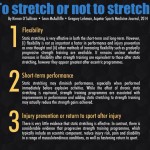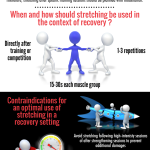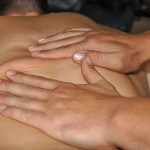To stretch or not to stretch when warming up?
In general, stretching to warm up is seen as an action which increases a person’s performance, and decreases their risk of injury. Evidence of both has been widely debated, with authors of papers claiming that stretching does help increase performance and decrease injury risk. In a clinical setting the opposite is being argued.
The type of sport you play can make quite a difference with how flexible your muscles need to be. If the sport involves lots of running and jumping, e.g. basketball or football, these sports require a high intensity stretching cycle. These sports need the muscle tendon unit, e.g. Achilles tendon and the gastrocnemius in the calve to be compliant. If it isn’t supple enough, the energy will be too much for the muscle tendon unit within the gastrocnemius, which leads to a heightened injury risk.
If however a low intensity stretching cycle is required, sports for example include cycling, swimming or jogging, the opposite needs of a muscle tendon unit are required. The unit needs to be stiffer, to help the Achilles tendon transfer the force generated by gastrocnemius.
A paper (To Stretch or not to Stretch?) looked at previous reviews, and concluded that in the short term, a static stretch held for 45 seconds decreases maximal strength, jumping ability and agility and has no significant effect on performance. This would be more applicable to sports such as football, rugby and tennis etc.
In regards to Static Stretching and endurance performance, the results and conclusions from studies are not as clear cut compared to the above. With some studies saying that static stretching reduces performance, other studies saying that it has no affect. Very few studies however state an improvement in performance from stretching.
With the above evidence, it is hard to support the use of Static stretching immediately prior to an endurance event, or in a sport which requires multiple movements and maximal strength, as performance is likely to be reduced with no other clear benefit to you the athlete.
In regards to reducing injury risk, the same conclusion is reached for static stretching “do not support the use of stretching for injury prevention purposes, neither before or after exercise.” Progressive strength training is considered a much better factor for injury prevention, with a meta-analysis of previous studies concluding that strength training can cut injury rates to less than a third.
The most important information to take from this, is that for getting you to full range of movement of a joint, static stretching is fine. However when full range of movement is achieved, static stretching during warm up for an increase in performance or for a decrease in injury rate is arguably pointless.
http://www.aspetar.com/journal/upload/PDF/201412891228.pdf Stretch or not to stretch
http://andsonmenezes.com.br/artigos/Alongamento_Prevencao_Lesoes.pdf Stretch cycles for different sports
Check out YLM sport science for their infographics on a multitude of sport exercise science papers









